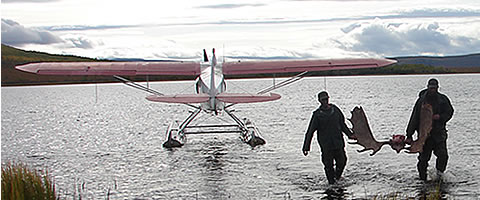When chartering a bush plane, there are several things to keep in mind.
In no particular order, they are as follows:
1. The type and size of the aircraft that will best accomplish my goals. The primary bush planes used in Alaska (from small to large) are as follows: Piper Super Cub; Cessna 170, 180,185, 206, 207 and Caravan; DeHavilland Beaver and Otter, Grumman Widgeon and Goose. All of these planes can be configured with wheels, floats or skiis except the Grumman aircraft which can operate on land and water, but not on snow.
2. Do I have a specific destination that I wish to go to (eg. the confluence of 2 rivers, etc.), or is my goal more generic (e.g., fishing for king salmon or moose hunting, etc.)? Unless you've been to a specific remote area of Alaska many times before, you might be best served by looking for a flying service that knows his area well and what it has to offer. It's rather like asking the waiter what's good on the menu. If you don't like what he's offering move on to the next flying service. Some specialize in hunting and/or fishing trips while others specialize in flightseeing.
3. What is the experience and safety record of the pilots that fly for the bush plane service that I want to use? See Flying Alaska Safely which is an FAA website and more importantly use your common sence. Don't be too embarassed to ask questions.
4. How many people are in my party and how much gear are we transporting? Bush planes are able to stay in the air only if they are configured and loaded within the particular aircraft's allowable "weight and balance". It's easiest to think in terms of a bush planes "useful load" however. While a Beaver can seat up to 8 people and it's useful load is 2100 lbs (almost the weight of a Super Cub), nevertheless for practical purposes a party of 5 passengers with light gear is what a normal operator and the plane would allow for a day fly in fishing trip. In almost every instance, it's the weight of your gear plus the number in your party that will determine the type of plane you need. Sometimes however, it is cheaper to have a smaller plane make several trips rather than chartering a larger plane like an Otter or Goose and try to do it all in one trip. If you are chartering by the flying hour, it's easier to compare costs if you know the exact flying time to your destination.
5. Do I want a fly-in, drop off, pick up later type of bush plane service (guided or unguided for fishing, hunting, or sightseeing),
a guided day trip, or one way service? Most, but not all, flying services in Alaska will offer all of these options and you should confirm what they are offering by telephone after viewing the flying service's website.
6. Can I get part of the way to where I want to go in Alaska by a regional carrier? If you are headed into the Arctic or Western part of Alaska, you may well be able to get part way to your destination by a regional carrier which will save you money. Regional carriers fly out of Anchorage to such places as Bethel, Aniak, Nome, Kotzebue, Kodiak, and many other smaller towns in Alaska. Regional carriers out of Fairbanks can take you to such places as Anatuvik Pass and other villages up North.
7. If I'm doing an unguided drop off hunt, can the same type of bush plane that got me in also bring me out with the animal I harvested? (note: see game regulations which require that all "edible meat" must be salvaged and transported from the field) If you're moose hunting, the meat, horns and cape may approach a 1000 lbs which is more than the useful load of some bush planes thus requiring multiple trips for which you may be charged. That's okay and frequently happens, just make sure you clearly understand what the flying services are going to charge you beforehand.
Overview of Alaskan Bush Planes
Bush planes operate in rugged terrain, necessitating they be equipped with tundra tires, floats or skiis. A bush plane should have good short take-off and landing capabilities which usually requires that they are equipped with a STOL package which are additional slats on the wings designed to reduce the possibility of stalls at low landing and take off speeds. A typical bush plane will have wings on top of its fuselage to ensure that they do not make contact with any overgrowth in the landing area. Such high wing configurations also allow greater visibility of landing areas as well as in spotting game. A good bush plane for landing on rough surfaces such as gravel bars and beaches will normally have conventional ("tail-dragger") landing gear as it has a greater aeronautic ability than tricycle landing gear ("nose wheel"). The increased upward angle of the taildragger configuration gives the propeller more clearance from the ground allowing it to avoid striking large rocks, logs and other debris that might cause damage. |




